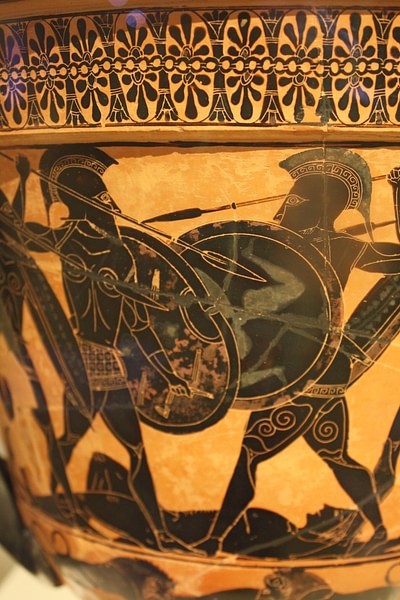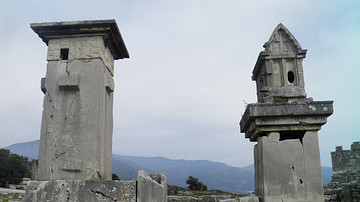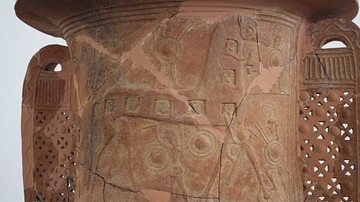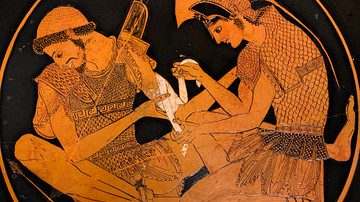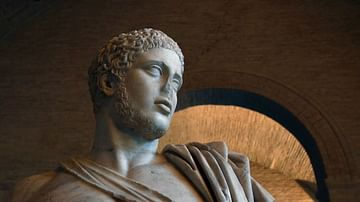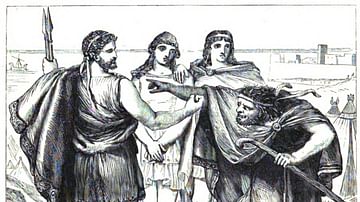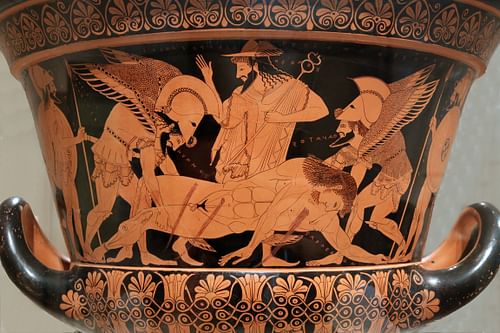
Sarpedon is a figure from ancient Greek mythology, a Lycian prince who was one of the principal heroes during the Trojan War and fought on the side of Troy. According to Homer's Iliad, he was the son of Zeus by Laodameia and the cousin of Glaucus of Lycia, the second-in-command of the Lycian forces, although other versions of the myth provide a different genealogy. He was a dominant force in battle and commanded the respect of the Trojan prince Hector and his peers. Patroclus, dear companion of the hero Achilles, slew Sarpedon during the Trojan War, but with Zeus' help, Sarpedon's body was conveyed back to his homeland of Lycia after his death, where he was buried with honour.
Genealogy
In the Iliad, the Sarpedon who fights at Troy is the grandson of the hero Bellerophon, the famous slayer of the Chimera and the one who captured the flying horse Pegasus. Hailing from Corinth, Bellerophon found himself in the service of King Iobates of Lycia because of the treachery of Stheneboia, the wife of King Proitos of Tiryns. During his service to Iobates, Bellerophon faced off with the fearsome Chimera, a fire-breathing monster that was a mixture of a lion and goat with a snake for a tail. During another outing, with the help of the goddess Athena, Bellerophon was able to tame the flying horse Pegasus, who was born from the severed head of the Gorgon Medusa after the hero Perseus had killed her.
Bellerophon had three children named Isander, Hippolochos, and the mother of Sarpedon, Laodameia. Both Isander and Hippolochos were vying for the throne of Lycia. To prevent a war of succession, the brothers made a proposition to shoot an arrow through a ring placed upon the breast of a child. When Laodameia offered her son for the exploit, both uncles and his cousin Glaucus withdrew their claim and elevated Sarpedon to the throne of Lycia.
Other versions of the myth describe Sarpedon as the son of Zeus and Europa, and the brother of Minos, the King of Crete. In this version, Sarpedon and Minos are both vying for the throne of Crete after the death of their father. As a result of the infighting, Sarpedon is exiled to the Asian mainland, where he establishes himself as the King of Lycia. Another version holds that the Sarpedon who fought at Troy was the grandson of Sarpedon, the brother of Minos.
The Trojan War
The Trojan War was the result of the abduction of Queen Helen of Sparta by the Trojan prince Paris. King Menelaus, outraged by the audacity of the Trojan visitor on his shores, persuaded his brother, King Agamemnon of Mycenae, to gather all his allies and sail to Troy to win back his wife. The Greek fleet that sailed over the Aegean consisted of more than a thousand ships. The war, which was to last ten years, involved many heroes and even involved the Olympian gods who had vested interests on both sides. The war finally came to an end when the Greeks entered and sacked the city with the help of a large wooden horse.
The Lycian forces under Sarpedon were considered the most robust of all the allies of Troy; the 'bulwark of Ilion.' Sarpedon was highly regarded as one of the greatest defenders of Troy, who was much the same as the Trojan heroes Hector and Aeneas regarding fighting prowess. Glaucus, the son of Hippolochos, accompanied Sarpedon to Troy along with his troops from Xanthos. Himself a prominent warrior, Glaucus meets the Greek hero Diomedes on the battlefield, who is leading the Greek forces with the help of the goddess Athena. Glaucus and Diomedes exchange words and upon learning about each other's ancestry, the two warriors decide to not fight each other despite being on opposing sides. Coincidentally both their grandfathers shared a bond of friendship in the past. They continue the tradition of friendship by giving each other their own armour as a gift and part ways as friends. It is during this time that Sarpedon happens upon Tlepolemus, who is the son of none other than the Greek hero Heracles. After trading insults, Tlepolemus is defeated and killed, although he injures Sarpedon in the left thigh.
Sarpedon commanded so much influence during the war that he criticized Hector during battle. On one occasion, Sarpedon accuses Hector that he is leaving the heavy fighting to the Trojan allies rather than the Trojans themselves. This interaction between the two heroes leads Hector to rally his men and push forward on the Greek position. The “god-like” Sarpedon, along with both his cousin Glaucus and another Trojan ally Asteropaios storm the Greek fortifications helping Hector breach the defences of the Greeks.
Because of a quarrel between King Agamemnon, the leading commander of the Greek forces, and Achilles, the best and bravest of all the Greek warriors, Achilles and his Myrmidons refrained from participating further in the war. The absence of Achilles prompts the Trojans to exploit the situation and attack the Greek encampment until one of the Greek ships is finally set alight. During this time, Patroclus begs Achilles to return to the battlefield and help defend the ships against the approaching Trojans. Achilles yields and gives Patroclus his armour to wear to instil fear into the opposing Trojans. Believing that Achilles is back in the fight defending the ships, Sarpedon meets Patroclus on the battlefield.
Zeus, knowing that fate is at hand and that the death of his son is drawing close, considers saving Sarpedon from death by removing him from the battle. Hera confronts Zeus and warns him that the other Olympians deities would not look kindly on such an act of divine intervention, as many of them have children of their own on the battlefield. Zeus relents and compromises by guaranteeing to send Sarpedon's body home to Lycia after his death by the hand of Patroclus.
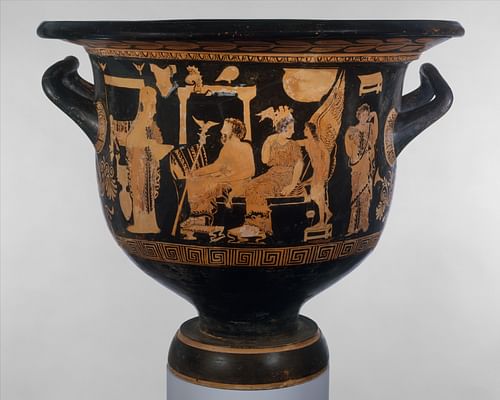
Glaucus, filled with anguish and sorrow over his fallen commander and cousin, reminds Hector of his duty to the Trojan allies. Fierce fighting breaks out around the body of Sarpedon as both sides aim to claim the body of the Lycian commander. Just as Trojans take the armour from his body, Apollo appears, accompanied by Hypnos and Thanatos, to cleanse the body and ease it back to Lycia. Glaucus follows in the steps of Sarpedon by leading the Lycian troops after his death.
The Cult of Sarpedon
Sarpedon was a well-known figure in Asia Minor because of his involvement in the Trojan War and the myth of how he came to settle in Lycia after his exile from Crete. The area of Sarpedon's devotion was on Xanthos where, according to Homer and Aristotle, he was buried. Later, during the 5th century BCE, a large temple complex was built on Sarpedon's supposed burial site at the acropolis on Xanthos. This complex was known as the Sarpedoneia, where games were held and regular sacrifices were made in honour of the Lycian hero.
Representations in Art
Various iterations of Sarpedon are found in art, mostly illustrating his death and the subsequent removal of his body from battle by Hypnos and Thanatos. A terracotta bell-krater (a mixing bowl), now in the Metropolitan Museum of Art, shows Europa imploring Zeus for the life of Sarpedon on one side, while the reverse illustrates Europa observing the return of Sarpedon's lifeless body back from Troy. Sarpedon is also represented in an 1874 CE oil canvas painting by Henri Levi. The painting, which is housed at the Musee d'Orsay, illustrates the dramatic conveyance of Sarpedon's body to his father Zeus by Hypnos and Thanatos.
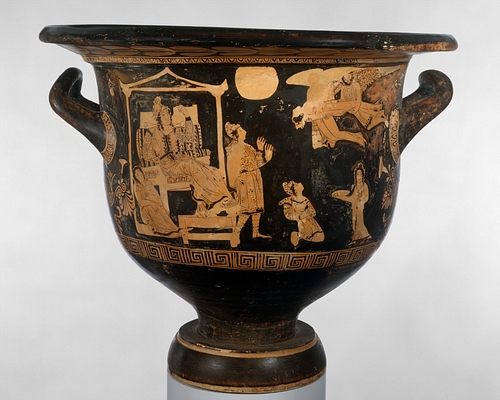
Possibly the most famous iteration of Sarpedon comes in the form of the Sarpedon Krater (see title image) which, until recently, was housed in the New York Metropolitan Museum of Art, after which it was repatriated to the Museum of Cerveteri in Italy. The image embellished on the krater shows Sarpedon after he has fallen by the hand of Patroclus and being transported from the field of battle by Sleep and Death by the command of Zeus. This piece of terracotta art was crafted by Euxitheos and Euphronios, both Athenians, in the 6th century BCE.
Another piece of prominent art regarding Sarpedon is an Etruscan bronze handle of a cista which possibly portrays Sleep and Death carrying the body of Sarpedon from the battlefield. If the bronze handle is not that of Sarpedon, it is widely believed to be that of the Ethiopian king Memnon who was killed by Achilles.
